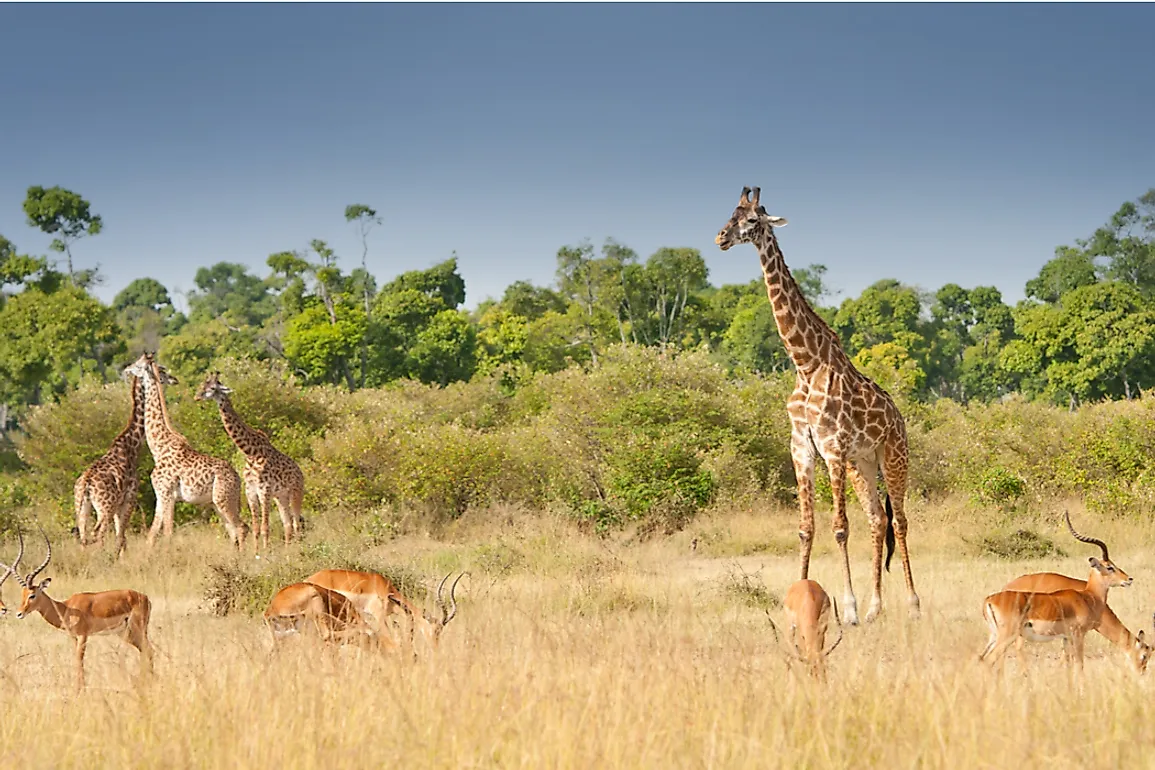Where Do Giraffes Live?

Giraffes are vulnerable African mammals known for being the tallest animal on land and the most massive cud-chewing animal. Giraffes belong to the family Giraffidae with their closest relative being the okapi whose natural habitat is the northeast region of the Democratic Republic of Congo. The giraffe's long neck is one of the animal’s most distinctive feature, and it allows them to reach various food sources located high in trees. Giraffes also have a distinctive spot pattern unique to each. At one point there were eight species of giraffes, but seven have gone extinct. The single living species of the giraffe has nine subspecies scattered across the African continent.
Subspecies of Giraffe
Today, giraffes are found in Niger, Chad, Sudan, Cameroon, Central African Republic, South Sudan, Ethiopia, Uganda, Kenya, Somalia, Zambia, Namibia, Zimbabwe, Mozambique, Botswana, and South Africa. Each of the nine subspecies of giraffes has its own geographic range among the countries list above.
Reticulated Giraffe
One of the most well-known species of giraffe is the reticulated giraffe that inhabits the horn of Africa. Its natural range extends across three countries, which include Kenya, Somalia, and Ethiopia with an estimated population of 8,500 wild individuals. Due to the low population, the reticulated giraffe is considered vulnerable with various organizations cooperating to increase the population.
Rothschild Giraffe
The Rothschild giraffe, with a population of about 1,671 wild individuals, is one of the most endangered species of giraffe. The native population is currently limited to two states of Kenya and Uganda. They favor savannahs and woodland regions with some of the best spots to see them in the wild being the Kenyan Lake Nakuru National Park and the Ugandan Murchison Falls National Park.
West African Giraffe
The West African giraffe is an endangered giraffe subspecies that inhabits the Sahel region of West Africa. The subspecies is unique due to its spots which are of a lighter shade than other giraffes. The West African giraffe once occupied an extensive range of territory across Africa, but the population has reduced to 400 individuals. A herd located in the southwest of Niger is the only self-sustaining herd globally.
Nubian Giraffe
The Nubian giraffe is a vulnerable subspecies of giraffe extinct in three countries where it was once prevalent in Eritrea, the Democratic Republic of Congo, and Egypt. At the moment populations of Nubian giraffes are present in five states in Sub-Saharan Africa including Sudan, Uganda, South Sudan, Kenya, and Ethiopia.
South African Giraffe
The South African giraffe is also referred to as the Cape giraffe and has a range covering nations in the south of Africa from Mozambique to South Africa. At 31,500 wild individuals, the population of South African giraffes is more significant than other subspecies.
Angolan Giraffe
There are approximately 13,000 wild Angolan giraffes inhabiting its habitat that covers four southern African states of Namibia, Botswana, Zimbabwe, and Zambia. There are about 20 Angolan giraffes in captivity.
Rhodesian Giraffe
The Rhodesian giraffe only lives in a single country, Zambia. There are approximately 550 individuals all of which reside in the South Luangwa Valley. No Rhodesian giraffes live in captivity.
Kordofan Giraffe
The Kordofan giraffe is a subspecies of the giraffe with a wild population of about 2,000 individuals. The subspecies is relatively smaller than other types of giraffes. They are found in Central African Republic, southern part of Chad, Northern region of Cameroon, and probably Sudan.
Conservation of Giraffes
The global population of giraffes is estimated to be 80,000 individuals who are a significant decline from the 1999 population comprising of 140,000 individuals. The Giraffe Conservation Organization is one of many organizations working to ensure an increase in the global population.











